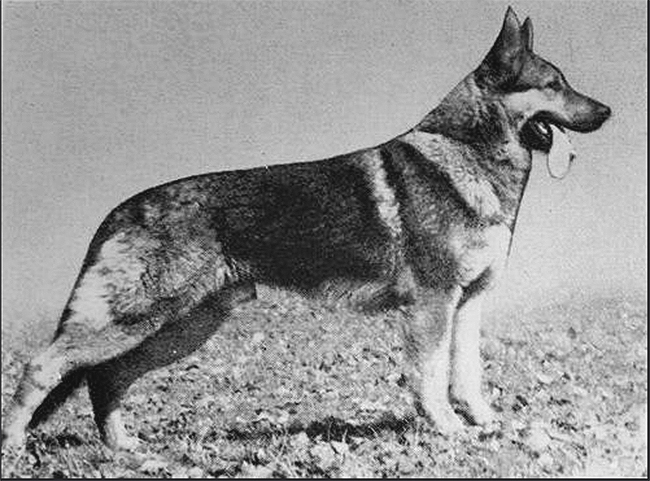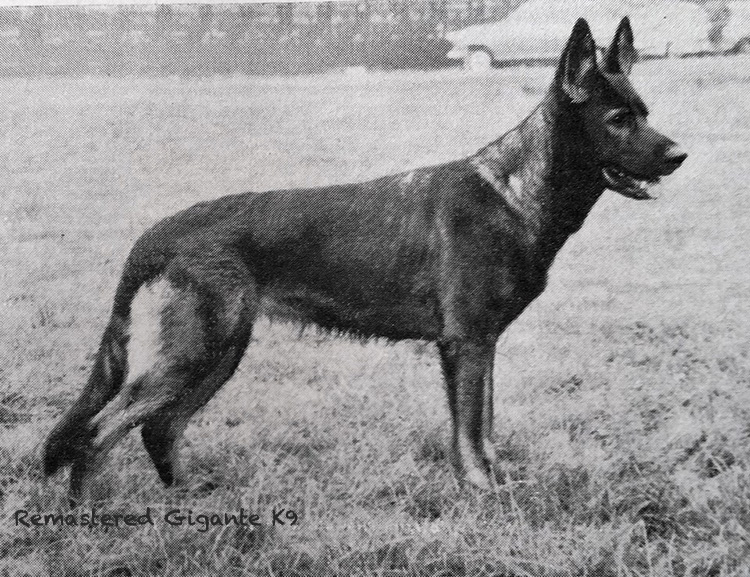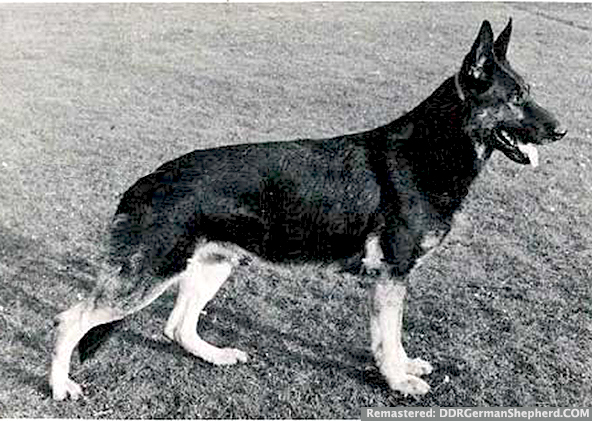In the further course the most important question arises again and again..

The best way to illustrate the development is, as in previous years, to present a list of the most influential males and females from the 1967 Siegerausstellung. We award 3 points for each offspring of a sire or dam that was placed 1st to 10th with the mark “Excellent” or in the younger classes with the mark “Very good”. For all other animals with the grade “Very good” 2 points and for those that received the grade “Good” 1 point. If there is 1 animal among the offspring that receives “satisfactory” or “poor”, 1 point is deducted.
Column I of the table shows that different numbers of offspring were produced by the individual sires and dams. In order to find a uniform denominator for this, I have divided the total number of points (column II) by the number of offspring presented (column I) and thus obtained an approximate index of the heredity of the parent animal in question………
If we now examine breeding as a whole, two networks run through it, many of which intertwine, cross and are intertwined. These are, on the one hand, the influential families with their male offspring and, on the other hand, the bitches, which exert a significant influence on breeding. In the breeding circles there is far more knowledge about the males in the generation sequence and pedigree than about the bloodline of the bitches, which has its cause in the fact that the male dog is far more accessible to the judgment of the breeder and that he leaves a larger number of offspring, while a bitch brings at most 4-12 offspring per year. In heredity, however, the bitch should be given the same importance as the male.

Just as there are males who consistently pass on their advantages as well as faults to their offspring, even with moderate bitches, we also have individual bitches with good hereditary power and those who establish quite successful bitch lines. In order to get a picture of the most successful bitches, we present a table of bitches with at least 3 offspring, according to the same assessment as for the males in Table I.
Breeding practice proves again and again that our best males, no matter how pronounced their individual potency may be, are usually unsuccessful with bitches whose type was foreign to them and who could not offer them a blood connection. It is also noticeable that the most successful bitches at the 1967 Main Breeding Show were in their family type and were quite solid in blood. This was particularly noticeable in the mothers of the younger top dogs. If we take a look at such a pedigree of the younger top animals, we can see that not only they themselves, but in many cases their parents were already inbred, and that the inbreeding apparently also breaks out in the individual potency.
Only when individual potency has been achieved in this way will we obtain the males and females that will guarantee us a reliable heredity. They will then form the stock of valuable breeding material and are the reservoirs of consolidated blood, which will also hold their own with the offspring from other families. There is no other way to prevent valuable lines and families from breaking up than to keep them together through inbreeding,
Everywhere in animal breeding where lines and families with breeding influence have developed, they have only gained importance through inbreeding. To elevate the naked thoughtless individual potency to a “dogma” cannot lead to the goal if the driving forces behind it are not inbred ancestors. It is quite possible that a certain individual potency can be achieved by a fortunate combination of similarities, but on the other hand, with every blood refreshment with un-selected material, new factors unknown to us must be reckoned with, which are only recognized when it is already too late. The outstanding results of canine performances at the German Championships in 1967 clearly show, as do the excellent breeding results of the past few years, that our breeding stock contains first-class qualities.

In the difficult to calculate questions of breeding work, the breeding principle that the most progressive breeding method must be based primarily on offspring similarity, the utilization of the parents and for the best breeding results, will prove itself time and again.
The importance of the breeding evaluation is based on the information about the hereditary value of an animal. Through the addition of pictures we try to bring the hereditary tendency of the individual families closer to the sport friends, on the other hand we give a cross-section and insight into the breeding. Due to sometimes rather poor pictures, it is not always possible to put the individual animals in the right light. Despite all their shortcomings, however, the photographs are a welcome mediator, which also leaves some room for the viewer’s own judgment.
Unfortunately, we have to state again and again that some owners of excellent dogs do not always support our efforts to produce good stand shots with the same understanding. As far as possible, we have procured pictures, but unfortunately it was not always possible in all cases and often with great difficulty.
Breed Warden Hirsch 1967